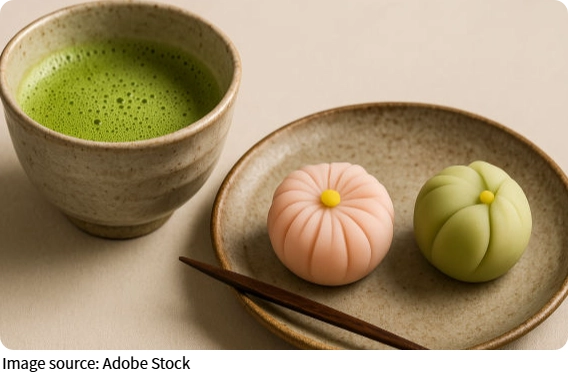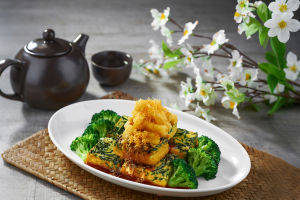Seasons of Japanese Sweets

let's take a delightful journey into the colorful and enchanting world of wagashi, the traditional Japanese sweets with a rich variety and delicate sweetness.
Beyond common Japanese dishes, wagashi represents a unique fusion of flavor, art, and seasonal storytelling.
Each piece is more than a dessert—it is a miniature work of art that reflects Japan's culture, nature, and the meticulous craftsmanship of generations. Today, we can explore the many varieties, the seasonal inspirations, and the delightful experience of tasting wagashi together.
The Variety of Wagashi
Wagashi comes in an incredible array of shapes, colors, and textures. From soft mochi to smooth yokan, and from crisp senbei to fluffy manju, each type brings its own unique charm. The ingredients vary widely, usually including rice flour, sweet beans, sugar, and natural flavorings, while some incorporate seasonal fruits, nuts, or flower essences.
Wagashi can be steamed, baked, or molded, and every piece is crafted to look as beautiful as it tastes. When we bite into wagashi, the textures—chewy, smooth, or slightly crunchy—create a multi-layered sensory experience, making it a treat for both eyes and palate.
Spring: Cherry Blossom Inspiration
Spring is perhaps the most celebrated season for wagashi. Cherry blossoms inspire confections shaped like delicate petals or tiny flowers, often filled with sakura-flavored bean paste. Artisans carefully sculpt each piece, adding subtle patterns that mimic blooming blossoms, while the pastel colors reflect the softness of the season.
Imagine sitting under a cherry tree, enjoying a wagashi infused with sakura essence—each bite captures the freshness and beauty of spring. Seasonal ingredients and designs change with the months, offering us a new and exciting taste of the season every time we visit a wagashi shop.
Summer: Goldfish and Water Lilies
Summer wagashi draws inspiration from goldfish, morning glories, and water lilies. These designs evoke the warmth, playfulness, and vibrancy of the season. Artisans use bright colors and fresh ingredients to bring summer motifs to life, creating sweets that are not only tasty but visually captivating.
Some are chilled or served with crushed ice, adding a refreshing element to the flavor. Eating summer wagashi allows us to feel the liveliness of the season and enjoy a fleeting moment of cool delight, perfectly complementing the hot, sunny days.
Autumn: Harvest Colors and Chestnuts
Autumn wagashi celebrates the season of harvest. Chestnuts, sweet potatoes, and seasonal fruits dominate the flavors, while warm shades of red, yellow, and brown reflect the changing leaves and the richness of the land. Artisans carefully combine colors, shapes, and textures to recreate the feeling of autumn landscapes in miniature edible forms.
When we savor these sweets, we can feel the cozy and nostalgic atmosphere of fall. The vibrant appearance, combined with the natural sweetness, makes autumn wagashi a feast for both the eyes and the taste buds.

Winter: Snowy Plums and Warm Comfort
Winter wagashi often depicts frosted petals, berries, and snow. Bright-colored mochi with soft, sweet barley or bean filling offers warmth during cold days. Artisans shape each piece to reflect snow-covered petals or frosted landscapes, bringing beauty and comfort even in winter.
We can imagine sitting by a window as snow falls gently outside, sipping warm tea, and enjoying a wagashi that captures the essence of the season. The combination of texture, sweetness, and visual charm makes winter wagashi a perfect treat for quiet, reflective moments.
The Art of Tasting Wagashi
Tasting wagashi is a full sensory experience. Beyond flavor, the visual presentation and the textures make every bite memorable. Pairing wagashi with tea enhances the experience, as the slight bitterness of tea balances the sweetness, creating a harmonious flavor combination. In summer, adding crushed ice or chilling the sweets adds a refreshing note.
In winter, pairing warm tea with soft, sweet wagashi creates a comforting ritual. Sitting together in a tea house or wagashi shop, we can slow down, appreciate the colors, shapes, and tastes, and feel a deep connection to Japanese culture and seasonal rhythm. Wagashi captures seasonal moments, letting us enjoy artistry through every bite.
Why We Love Wagashi
We love wagashi because it’s not just food—it's an experience that combines art, culture, and the rhythm of nature. Each piece invites us to pause, admire, and savor. Sharing wagashi with friends or enjoying it quietly allows us to connect with the seasons, the skill of artisans, and the beauty of simple, refined flavors.
Every bite carries a story and celebrates the Japanese appreciation for aesthetics and tradition, making wagashi a sweet way to experience life.
Enjoying Wagashi Together
Lykkers, wagashi isn't just a sweet treat—it's a journey through taste, beauty, and Japanese tradition. From the wide variety of confections to seasonal inspirations and meticulous craftsmanship, every piece tells a story. By exploring these delicate sweets, we can enjoy not only their flavors but also the artistry and care behind them.
Let's savor wagashi together, celebrating each color, shape, and taste that makes this traditional Japanese delight so unforgettable.
Only The Wealthy Could Eat This Intricate Japanese Sweet. Now It's A National Delicacy
Video by Business Insider India


